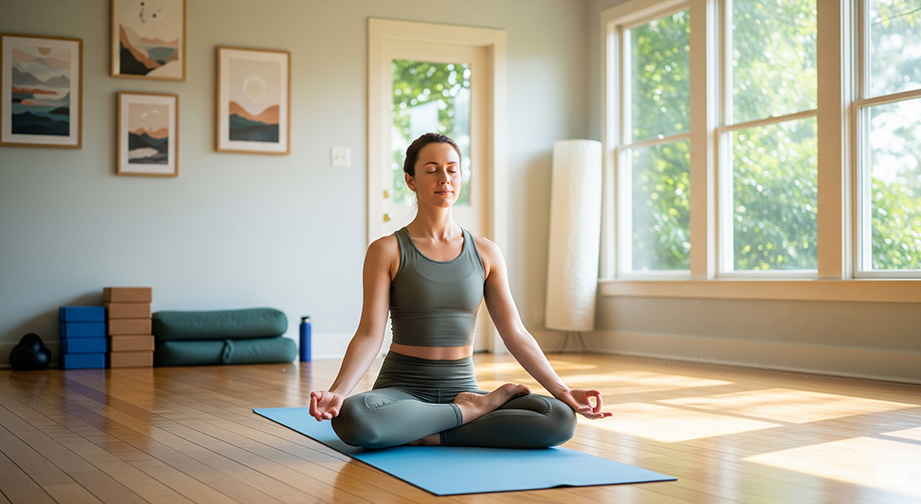Svastikasana (Auspicious Pose): The Ultimate Beginner’s Guide
Introduction
Svastikasana (pronounced sva-STEE-kah-sa-na) is a classic seated yoga posture that’s all about grounding and quieting your mind. In Sanskrit, “Svastika” means “auspicious” or “lucky mark”, and “asana” means “pose.” The essence of this asana is calm steadiness and gentle energy balancing.
If you’ve ever felt stiff after sitting too long or craved a comfortable, mindful way to sit, Svastikasana is your new best friend—it’s simple, supportive, and accessible for most body types.
Step-by-Step Guide to Practicing Svastikasana

- Prepare Your Space: Sit on a yoga mat or cushion with your legs stretched out in front of you. Shake out your legs and relax your body.
- Fold the Left Leg: Bend your left knee and place your left foot snugly against the inside of your right thigh.
- Bend the Right Leg: Now, bend your right knee and draw your right foot in. Place it just above or in front of the left ankle, tucking the toes and outer edge of the foot comfortably into the space between your left calf and thigh.
- Align the Knees: Your knees should rest comfortably towards the floor, as close together as possible.
- Rest Your Hands: Place your hands on your knees (palms up for energy, palms down for grounding) or in a mudra of your choice.
- Lengthen Your Spine: Sit up tall, roll your shoulders back, and tuck your chin slightly for a long neck. Gaze softly forward or close your eyes.
- Breathing: Inhale deeply, feeling your belly and chest expand. Exhale slowly, softening your jaw and shoulders. Keep your breath slow and rhythmic throughout.
- Stay & Switch: Hold Svastikasana for 1–3 minutes (about 8–12 deep breaths). Switch the cross of your legs and repeat on the other side to balance your body.
Modifications for Beginners: Sit on a folded blanket or block if your hips are tight. Place cushions under the knees for extra support.
For Advanced Practitioners: Deepen the experience by practicing Pranayama (breathwork) or meditation in this position for up to 10 minutes.
Alignment & Safety Tips
- Key Cues: Sit evenly on both sit bones. Keep your spine lengthened and shoulders relaxed. Avoid slouching or letting the knees pop up too high.
- Watch for: Tension in the jaw, shoulders, or hips—breathe into tight spots.
- Common Mistakes: Don’t force your knees down; let them open naturally. Don’t round your back.
Safety Precautions:
- Avoid if you have recent or chronic hip, knee, or ankle injuries.
- If pregnant, sit higher with props and keep legs loosely crossed.
- Consult a medical professional if you have specific joint concerns.
Benefits of Svastikasana (Auspicious Pose)
Physical Benefits
- Improves hip flexibility and gentle opening of the groin
- Promotes proper posture and spinal alignment
- Relieves stiffness caused by long periods of sitting
Mental Benefits
- Calms the mind and reduces anxiety
- Encourages mindfulness and centering
- Supports meditation and breath awareness
Energetic/Chakra Benefits
- Grounds energy and balances the root chakra (Muladhara)
- Creates a steady, auspicious foundation for spiritual practices
Contraindications
- Avoid if you have severe hip, knee, or ankle injuries
- If sitting cross-legged is uncomfortable, use a chair or practice Sukhasana (Easy Pose) instead
Safe alternatives: Practice seated on a bolster or block, or try Sukhasana (Simple Cross-Legged Pose).
Beginner’s Tips & Variations
- Use Props: Sit on a folded blanket, bolster, or block to reduce hip and knee strain.
- Keep it gentle: You don’t need to force the position or keep your knees flat—comfort is key!
- Hands: Rest hands on knees, or try Gyan Mudra (thumb and index finger touch).
- Advanced: Prolong the sit for Pranayama or meditation, or combine with hand mudras and internal focus practices.
How to Include Svastikasana in Your Yoga Flow
Svastikasana is best used as a starting or ending posture. It sets the tone for meditation, breathing exercises, or simple mindfulness.
- Ideal for warm-up (to ground yourself before asana practice)
- Perfect for cool-down/relaxation or as a meditative seat
- Pairs well with poses like Cat-Cow (Marjaryasana-Bitilasana), Seated Forward Bend (Paschimottanasana), or Easy Pose (Sukhasana)
Mind-Body Connection in Svastikasana
As you sit in Svastikasana, tune in to your inner landscape. Notice the steady breath, the gentle sensations in your hips and legs, and the length of your spine. This is a pose for mindful presence and rooting your energy—perfect for meditation, intention-setting, or simply centering at the start or end of your day.
Spiritually, Svastikasana is said to activate and balance the root chakra, fostering a sense of safety and trust in the present moment.
Summary Box
- Asana Name: Svastikasana (Auspicious Lucky Mark Pose)
- Level: Beginner
- Focus Areas: Hips, spine, knees, grounding
- Duration: 1–3 minutes per side (or longer for meditation)
- Best Time to Practice: Morning or evening, during meditation or yoga practice
Frequently Asked Questions about Svastikasana
- Is Svastikasana safe for everyone?
It’s gentle, but not recommended if you have serious hip, knee, or ankle injuries. Support with props as needed.
- Can I meditate in Svastikasana?
Absolutely! It is one of the classic postures for seated meditation and breath practice.
- What if I can’t keep my knees on the ground?
No worries—prop up your hips, or place cushions under the knees. Flexibility comes with time.
This guide to Svastikasana (Auspicious Pose) is for educational use and not a substitute for professional medical or yoga instruction. Always listen to your body and practice with care.